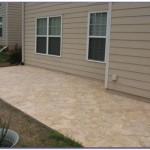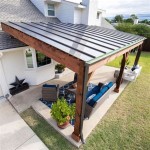How to Build a Patio with 16x16 Pavers
Constructing a patio is a significant landscaping project that can enhance outdoor living spaces and increase property value. Using 16x16 pavers offers a balance of manageable size and appealing aesthetics, resulting in a durable and visually pleasing patio surface. A well-planned and executed patio project will provide years of enjoyment. This article provides a step-by-step guide on how to build a patio with 16x16 pavers.
Before beginning any construction, it is crucial to consult local building codes and obtain any necessary permits. These regulations often dictate the requirements for drainage, setbacks from property lines, and other safety considerations. Neglecting to comply with local codes can result in fines and project delays. Furthermore, it is advisable to contact utility companies to locate and mark any underground lines to prevent accidental damage during excavation.
Planning and Preparation
The success of any patio project hinges on meticulous planning and preparation. This stage involves determining the patio's size and layout, calculating the necessary materials, and preparing the construction site. Accurate measurements and a well-defined plan will streamline the building process and minimize material waste.
1. Determine Patio Size and Location: The first step is to define the desired size and location of the patio. Consider the intended use of the space, such as dining, lounging, or entertaining. Also, assess the existing landscape, including sun exposure, drainage patterns, and proximity to the house. Mark the perimeter of the patio with stakes and string, ensuring the area is square using the 3-4-5 rule (a right triangle with sides of 3 feet, 4 feet, and 5 feet will ensure a 90-degree angle).
2. Calculate Material Requirements: Once the patio's dimensions are established, calculate the amount of materials needed. This includes the 16x16 pavers, base material (gravel), leveling sand, and edging. To calculate the number of pavers, measure the area of the patio in square feet and divide it by the area of a single paver (1.78 square feet for a 16x16 paver). Add an additional 5-10% for cuts and breakage. The amount of base material and leveling sand depends on the desired depth, typically 4-6 inches for the base and 1-2 inches for the sand. A material calculator can assist in accurately estimating the required quantities, accounting for compaction rates.
3. Gather Tools and Materials: Assembling the necessary tools and materials before starting construction is essential for efficiency. Essential tools include: Shovel, Rake, Wheelbarrow, Measuring tape, Level, Tamper (hand or plate compactor), Circular saw with a diamond blade (for cutting pavers), Safety glasses, Work gloves, and a Rubber mallet. The materials needed are: 16x16 pavers, Base material (crushed gravel or stone), Leveling sand (coarse sand), Edging material (plastic, metal, or stone), and Landscape fabric.
Site Excavation and Base Preparation
Proper site excavation and base preparation are critical for creating a stable and long-lasting patio surface. This involves removing the existing soil, creating a level base, and compacting the base material to prevent settling and shifting of the pavers.
1. Excavate the Area: Using a shovel, excavate the area within the marked perimeter to a depth of 6-8 inches. This depth accounts for the base material, leveling sand, and paver thickness. Ensure the excavation is uniform and level, using a laser level or string level to maintain accuracy. If the existing soil is unstable or contains organic matter, it may be necessary to excavate deeper and replace it with compacted fill.
2. Install Landscape Fabric: After excavation, lay landscape fabric over the exposed soil. This fabric prevents weed growth and keeps the base material from mixing with the underlying soil. Overlap the edges of the fabric by at least 12 inches and secure it with landscape staples.
3. Add and Compact the Base Material: Pour the base material (crushed gravel or stone) into the excavated area, distributing it evenly with a rake. Aim for a base depth of 4-6 inches. Compact the base material thoroughly using a hand tamper or plate compactor. Multiple passes with the compactor are necessary to achieve proper compaction. Ensure the base is level and free of any high or low spots. A well-compacted base is essential for preventing paver movement and maintaining a smooth patio surface.
4. Install Edging: Install edging around the perimeter of the patio. Edging restraints prevent the pavers from shifting and maintain the patio's shape. Edging options include plastic, metal, or stone. Secure the edging according to the manufacturer's instructions, using spikes or stakes. Ensure the edging is flush with the top of the compacted base material.
Paver Installation and Finishing
The final stage involves laying the 16x16 pavers, leveling them, and filling the joints with sand. Proper paver installation ensures a smooth, even surface that is aesthetically pleasing and functional. Careful attention to detail during this stage will result in a professional-looking patio.
1. Add Leveling Sand: Spread a layer of leveling sand (coarse sand) over the compacted base material, creating a 1-2 inch layer. Use a rake to distribute the sand evenly and a screed board to achieve a smooth, level surface. The screed board should be long enough to span the width of the patio. Work in small sections, screeding the sand and immediately laying the pavers to prevent disturbing the leveled surface.
2. Lay the Pavers: Begin laying the 16x16 pavers, starting from a corner or straight edge. Position each paver carefully and gently tap it into place with a rubber mallet. Maintain consistent spacing between the pavers, typically 1/4 to 3/8 inch, using paver spacers if necessary. Check the level of each paver with a level and adjust as needed by adding or removing sand. If a paver needs to be cut to fit, use a circular saw with a diamond blade. Wear safety glasses and work gloves when cutting pavers. Stagger the joints between the pavers for a more visually appealing and structurally sound patio.
3. Level and Settle the Pavers: After all the pavers are laid, use a plate compactor with a rubber mat to settle them into the sand. The rubber mat protects the pavers from damage during compaction. Make multiple passes with the compactor, ensuring the entire patio surface is compacted evenly. This process helps to level the pavers and lock them into place.
4. Fill the Joints with Sand: Once the pavers are compacted, sweep fine sand (polymeric sand is recommended for increased stability and weed control) into the joints between the pavers. Use a broom to distribute the sand evenly, ensuring all joints are completely filled. Sweep away any excess sand from the patio surface. If using polymeric sand, follow the manufacturer's instructions for activation, typically involving light watering.
Maintaining the Patio
Regular maintenance helps preserve the appearance and longevity of the patio. This includes sweeping the surface to remove debris, cleaning stains promptly, and re-sanding the joints as needed. Preventative measures, such as sealing the pavers, can also extend the life of the patio and protect it from weathering and staining.
1. Regular Cleaning: Sweep the patio regularly to remove leaves, dirt, and other debris. This prevents the accumulation of organic matter that can stain the pavers and promote weed growth. Use a garden hose to rinse the patio periodically, removing any remaining dirt or grime.
2. Stain Removal: Address stains promptly to prevent them from becoming permanent. Use a mild detergent and water to clean most stains. For tougher stains, such as oil or grease, use a specialized paver cleaner. Follow the manufacturer's instructions carefully and test the cleaner on a small, inconspicuous area first. Avoid using harsh chemicals or abrasive cleaners, as they can damage the pavers.
3. Joint Maintenance: Over time, the sand in the joints between the pavers may erode or become dislodged. Replenish the sand as needed, ensuring the joints are completely filled. Polymeric sand is a durable option that helps prevent weed growth and stabilizes the pavers. Reapply polymeric sand according to the manufacturer's instructions.
4. Sealing (Optional): Sealing the pavers can protect them from weathering, staining, and fading. A paver sealer penetrates the surface of the pavers, creating a barrier against moisture and contaminants. Choose a sealer specifically designed for pavers and apply it according to the manufacturer's instructions. Sealing is typically recommended every 2-3 years.
Addressing Common Challenges
Despite careful planning and execution, certain challenges may arise during the patio construction process. These challenges can include uneven settling, weed growth, and paver movement. Understanding the causes of these issues and implementing appropriate solutions can help maintain the integrity and appearance of the patio.
1. Uneven Settling: Uneven settling can occur due to inadequate base compaction or unstable soil conditions. To prevent this, ensure the base material is thoroughly compacted and consider using a geotextile fabric to stabilize the soil. If settling occurs, remove the affected pavers, re-compact the base, and reinstall the pavers.
2. Weed Growth: Weeds can grow in the joints between the pavers, detracting from the patio's appearance. Prevent weed growth by installing landscape fabric beneath the base material and using polymeric sand in the joints. Regularly inspect the patio and remove any weeds as soon as they appear. Herbicides can be used to control weeds, but use them sparingly and follow the manufacturer's instructions carefully.
3. Paver Movement: Paver movement can occur due to inadequate edging or unstable base conditions. Ensure the edging is securely installed and the base is properly compacted. If pavers shift, remove them, re-compact the base, reinstall the edging, and relay the pavers.

We Built A Paver Patio Like Pro Start To Finish

How To Build A Small Paver Patio Diy For Around 200 Bucks

We Built A Paver Patio Like Pro Start To Finish

How To Build A Small Paver Patio Diy For Around 200 Bucks

Best Patio Pavers For Complex Designs Dkc Landscaping Hardscaping Tree Services

Diy Pea Gravel Patio With Pavers Love Renovations

Installing Flagstone Pavers Paverblocks Backyardgoals Backyarddesign
Paver Patios Driveways 9 Trees Landscape Construction

Attempting An Octagonal Patio Sand And Sisal
Paver Patios Driveways 9 Trees Landscape Construction
Related Posts








